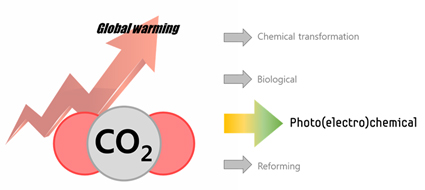
Research Theme
CO2 emissions are regarded as one of the main causes of global warming by the greenhouse effect. Numerous attempts have been carried out for CO2 capture and storage, but the eventual resolution may be the direct use of CO2 as a component of useful materials.
Therefore, the activation and reduction of CO2 are the ultimate goals of CO2 management. However, it is very difficult to overcome the activation energy barrier of C-O bond cleavage, and either high reaction temperature or large electrochemical potentials are often required. To this end, photocatalytic conversion seems to be a promising process under ambient conditions by harnessing solar energy, which makes it economical and environmentally benign.

- UV-active nanocatalysts
- Vis-active molecular catalysts
- Inorganic synthesis
- Reaction kinetics and selectivity
- Assembly into a reactor system
- Design of colloidal molecular and nano-catalysts
- Use of full-wavelength light
- Well-defined catalyst structure
- Synthesis of electrospun nanofibers
- Reactions under high pressure conditions
- Half-cell reactions with hole sacrificing agent in a solution
- Design f hybrid electrode for enhanced charge transfer


